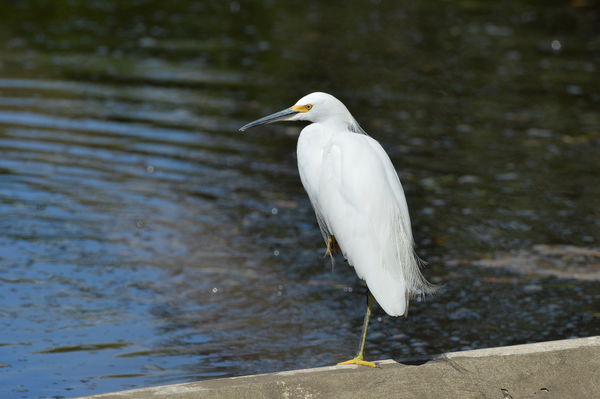Auto ISO
Oct 18, 2019 07:37:39 #
petego4it
Loc: NY
Another option is to combine auto iso with bracketing where the exposure in camera is likely to be fooled. Point is, as always, to get the best shot in camera and thereby need to do the least in post!!
Oct 18, 2019 07:45:30 #
petego4it wrote:
Another option is to combine auto iso with bracketing where the exposure in camera is likely to be fooled. Point is, as always, to get the best shot in camera and thereby need to do the least in post!!
Now wouldn't doing that be difficult? Since the auto ISO would keep dragging the overall exposure to the middle?
Oct 18, 2019 07:53:44 #
DaveJ
Loc: NE Missouri
CHG_CANON wrote:
If you kept the EOS 90D, you have a camera with a new feature most of the responses seem to be unaware of: EC with AUTO ISO in Manual. See the relevant pages in your manual.
This newish feature is also available in the predecessor to the Canon 90D, the Canon 80D. Page 197 of 80D manual. Can't post it today as low bandwidth in motel I'm in.
Oct 18, 2019 07:56:41 #
I have been experimenting with shooting train photos with auto ISO. I set my aperture and shutter speed in M and set an acceptable range of ISO for the Auto ISO in the camera.
I am using Evaluative metering mode primarily and occasionally Center Weighted. I care most about getting trains well exposed and if I blow out a cloudless sky I’m ok with that. I am also playing with shooting RAW + Large Jpeg where I normally shoot only RAW.
I am fortunate that my camera has a very good metering system with many sections to evaluate. I also know that I overexpose highlights by 2 stops and be OK. I will get blinkies sometimes but usually it is on the headlights or in the sky. If I want to reduce or eliminate the blinkies I can dial in some -EC, usually less than a stop will do it.
I also have the RAW file to work with if I need it.
I am using Evaluative metering mode primarily and occasionally Center Weighted. I care most about getting trains well exposed and if I blow out a cloudless sky I’m ok with that. I am also playing with shooting RAW + Large Jpeg where I normally shoot only RAW.
I am fortunate that my camera has a very good metering system with many sections to evaluate. I also know that I overexpose highlights by 2 stops and be OK. I will get blinkies sometimes but usually it is on the headlights or in the sky. If I want to reduce or eliminate the blinkies I can dial in some -EC, usually less than a stop will do it.
I also have the RAW file to work with if I need it.
saxman71 wrote:
Thanks for this question Will. It is clear to me that many of the professionals and/or those with considerable experience that shoot wildlife and contribute here use auto ISO regularly. I have had difficulty with it blowing out highlights. However, the last time I experimented with auto ISO I switched from spot to matrix metering and had much better success. Which leads to the question: is the selection of the metering mode an important consideration when using auto ISO?
Oct 18, 2019 08:06:21 #
bleirer wrote:
Now wouldn't doing that be difficult? Since the auto ISO would keep dragging the overall exposure to the middle?
No
Oct 18, 2019 08:12:41 #
BebuLamar wrote:
They are semantics alright. But they said that the meter is always right, they didn't say that it always gives you the right exposure. Just like I used to say that the meter is accurately wrong.
Not to put too fine a point on it but, if you are using Manual exposure plus Auto ISO, the exposure can never be wrong.
It's the ISO that can be too high or too low if the result is too bright or dark.
And in case anyone thinks I manipulated the two examples I just posted, here they are again - JPEG SOOC.
Oct 18, 2019 08:16:06 #
mizzee
Loc: Boston,Ma
I don’t use auto ISO when I’m in low light or changing light. What governs my decision is my ability to hand hold with whatever aperture i’ve chosen.
Oct 18, 2019 08:32:02 #
billnikon
Loc: Pennsylvania/Ohio/Florida/Maui/Oregon/Vermont
will47 wrote:
I was just doing some reading about Auto ISO. What drawbacks, if any, are encountered by using this on a regular basis?
I like to make the decisions for the camera, not the other way around. And no, the camera will work fine in Auto ISO. Many birds like it, I am a birder and do not use it.
Auto ISO can be fooled by too bright light like snow or sand just like auto anything you set on the camera. Again, in difficult lighting conditions I like to make the decisions.
Oct 18, 2019 08:32:57 #
BebuLamar wrote:
No
Can you explain? If one has ISO on auto and points the camera at a scene, any change in aperture or shutter will be compensated for by an automatic change in ISO, still giving an equivalent exposure, unless you add ec to the mix, or what part am I missing that would allow a bracketed exposure?
Oct 18, 2019 08:36:38 #
will47 wrote:
I was just doing some reading about Auto ISO. What drawbacks, if any, are encountered by using this on a regular basis?
My camera is set to auto ISO for the most part I can easily adjust the ISO setting with the command dial which I do regularly but I find that the auto ISO is pretty accurate and works for me
Oct 18, 2019 08:40:19 #
"The only drawback that I find is personal. I don't like the camera making decisions for me.
--Bob"
I feel the same way.
--Bob"
I feel the same way.
Oct 18, 2019 08:49:00 #
When I started using Auto ISO and a mandatory 1/500 sec, Aperture Preferred f11, I got a lot more keepers when shooting 8th grade soccer. (single point metering, all exposures were perfect, camera: D750)
Oct 18, 2019 08:50:22 #
will47 wrote:
I was just doing some reading about Auto ISO. What drawbacks, if any, are encountered by using this on a regular basis?
AUTO ISO! At first, an expert photographer probably would remark that this is extremely lazy. This is a misjudgement of course. I think many of us had forgotten how to properly use a light meter. So, you a on a daily adventure to find something to put in your viewfinder. Low and behold, it's a bird, a bug or even an unalloyed shaped tree or building. You grab your camera quickly. And, you press the shutter to nail the shot. You lost it because your last settings on your camera were in Portrait, your shutter was 1/125, your f/stop was f22 and your ISO 25600. You forgot to reset your triangle. You forgot to reset your White Balance. The next sound you hear, comes from your own mouth. It is "D&@mn!"
By keeping your setting at Auto you are afforded one reasonable and possibly decent shot. Then you can chimp and reset your shot, bracketing along the way and adjusting to get the best photograph possible.
There are no perfect circumstances and this method a can work with novices as well as professionals.
The Auto feature on cameras is designed to average everything and let the onboard computer create the best possible photograph.
There is a major caveat here. By using auto ISO you sacrifice the photographer's eye to interpret lighting. I remember the days when I carried a light meter. I loved that little gadget but I out grew it. So using an auto ISO will live its course as a person becomes a more proficient photographer.
I don't think there is anything wrong with Auto ISO because as you use it and adapt to constant light changing conditions , you become much more familiar with your rig.
Happy Shooting!
Oct 18, 2019 08:57:19 #
Ysarex wrote:
True for all Nikon and all other brand camera's as well. Manual mode means you are locking down the shutter speed and f/stop. If you do that (M mode), EC will not change the shutter speed or f/stop. If you do not change the shutter speed or f/stop the exposure stays the same (assuming consistent lighting).
Joe
Joe
Here is your statement that I referenced and not the one you made in this reply:
"With the camera in M+AutoISO+EC, adjusting the EC value will not change the exposure. It will likely result in the camera changing the ISO value but Manual mode locks the exposure such that an EC adjustment can not change it."
EC adjustment in auto-iso mode does in fact change the exposure in some cameras.

Oct 18, 2019 08:59:57 #
I agree that what you say is true except in the case where the camera lacks enough granularity in the ISO selection. My daughter has a Canon T3i and i believe it only allows ISO to be set in full stops. More advanced models allow the setting in 1/2 or 1/3 stops. I have not done testing extensively with her camera and Auto ISO but I would hope that it would slightly overexpose rather than underexpose.
selmslie wrote:
Not to put too fine a point on it but, if you are using Manual exposure plus Auto ISO, the exposure can never be wrong.
It's the ISO that can be too high or too low if the result is too bright or dark.
And in case anyone thinks I manipulated the two examples I just posted, here they are again - JPEG SOOC.
It's the ISO that can be too high or too low if the result is too bright or dark.
And in case anyone thinks I manipulated the two examples I just posted, here they are again - JPEG SOOC.
If you want to reply, then register here. Registration is free and your account is created instantly, so you can post right away.








